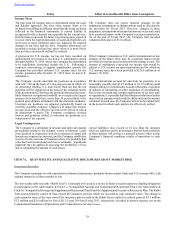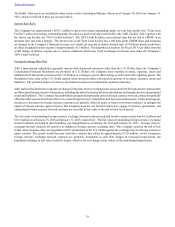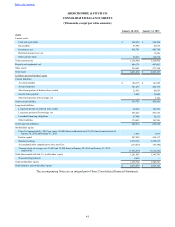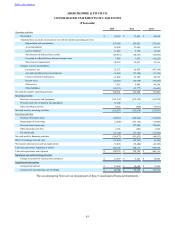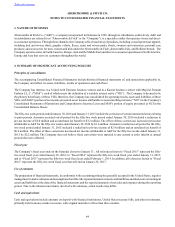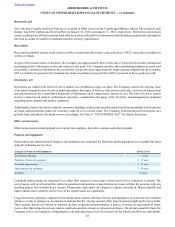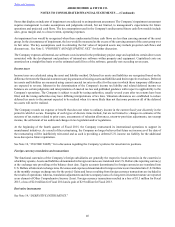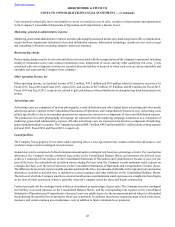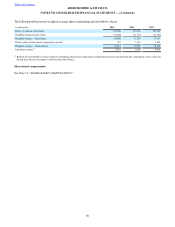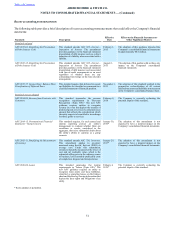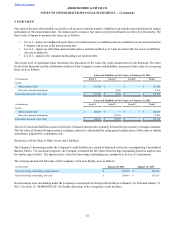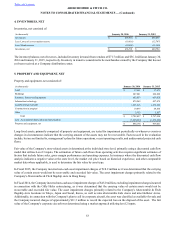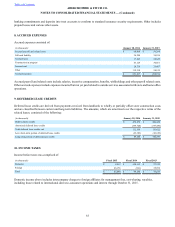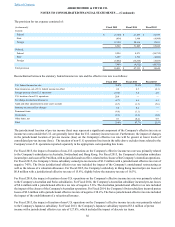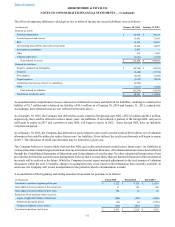Abercrombie & Fitch 2015 Annual Report Download - page 47
Download and view the complete annual report
Please find page 47 of the 2015 Abercrombie & Fitch annual report below. You can navigate through the pages in the report by either clicking on the pages listed below, or by using the keyword search tool below to find specific information within the annual report.
Table of Contents ABERCROMBIE & FITCH CO.
NOTES TO CONSOLIDATED FINANCIAL STATEMENTS — (Continued)
47
Stockholders’ equity
At January 30, 2016 and January 31, 2015, there were 150.0 million shares of A&F’s Class A Common Stock, $0.01 par value,
authorized, of which 67.3 million and 69.4 million were outstanding at January 30, 2016 and January 31, 2015, respectively, and
106.4 million shares of Class B Common Stock, $0.01 par value, authorized, of which none were outstanding at January 30, 2016
and January 31, 2015.
Holders of Class A Common Stock generally have identical rights to holders of Class B Common Stock, except holders of Class A
Common Stock are entitled to one vote per share while holders of Class B Common Stock are entitled to three votes per share on
all matters submitted to a vote of stockholders.
Revenue recognition
The Company recognizes store sales at the time the customer takes possession of the merchandise. Direct-to-consumer sales are
recorded based on an estimated date for customer receipt of merchandise, which is based on shipping terms and historical delivery
transit times. Amounts relating to shipping and handling billed to customers in a sale transaction are classified as net sales and the
related direct shipping and handling costs are classified as stores and distribution expense in the Company's Consolidated Statements
of Operations and Comprehensive Income (Loss). Sales are recorded net of an allowance for estimated returns, associate discounts,
and promotions and other similar customer incentives. The Company estimates reserves for sales returns based on historical
experience. The sales return reserve was $8.9 million, $9.5 million and $8.0 million at January 30, 2016, January 31, 2015 and
February 1, 2014, respectively.
The Company sells gift cards in its stores and through direct-to-consumer operations. The Company accounts for gift cards sold
to customers by recognizing a liability at the time of sale. Gift cards sold to customers do not expire or lose value over periods of
inactivity. The liability remains on the Company’s books until the Company recognizes income from gift cards. Income from gift
cards is recognized at the earlier of redemption by the customer (recognized as net sales) or when the Company determines that
the likelihood of redemption is remote, referred to as gift card breakage (recognized as other operating income). The Company
determines the probability of the gift card being redeemed to be remote based on historical redemption patterns. The gift card
liability was $36.4 million and $36.9 million at January 30, 2016 and January 31, 2015, respectively.
The Company is not required by law to escheat the value of unredeemed gift cards to the jurisdictions in which it operates. The
Company recognized in other operating income gift card breakage of $4.7 million, $5.8 million and $8.8 million for Fiscal 2015,
Fiscal 2014 and Fiscal 2013, respectively.
The Company does not include tax amounts collected as part of the sales transaction in its net sales results.
Cost of sales, exclusive of depreciation and amortization
Cost of sales, exclusive of depreciation and amortization, is primarily comprised of cost incurred to ready inventory for sale,
including product costs, freight, and import cost, as well as provisions for reserves for shrink and lower of cost or market. Gains
and losses associated with foreign currency exchange contracts related to hedging of inventory purchases are also recognized in
cost of sales, exclusive of depreciation and amortization when the inventory being hedged is sold.
Stores and distribution expense
Stores and distribution expense includes store payroll, store management, rent, utilities and other landlord expenses, depreciation
and amortization, repairs and maintenance and other store support functions, as well as direct-to-consumer expense and distribution
center (“DC”) expense.
Shipping and handling costs, including costs incurred to store, move and prepare merchandise for shipment, and costs incurred to
physically move merchandise to customers, associated with direct-to-consumer operations, were $115.0 million, $108.1 million
and $93.4 million for Fiscal 2015, Fiscal 2014 and Fiscal 2013, respectively. Handling costs, including costs incurred to store,
move and prepare merchandise for shipment to stores, were $44.5 million, $52.2 million and $53.9 million for Fiscal 2015, Fiscal
2014 and Fiscal 2013, respectively. These amounts are recorded in stores and distribution expense in the Company's Consolidated
Statements of Operations and Comprehensive Income (Loss).



